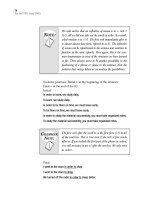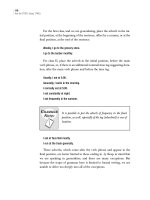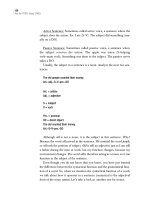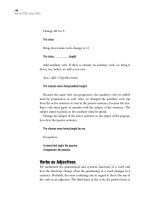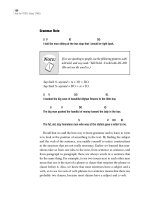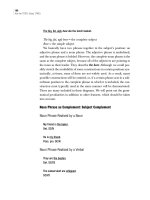Ace the toefl essay part 17
Bạn đang xem bản rút gọn của tài liệu. Xem và tải ngay bản đầy đủ của tài liệu tại đây (174.44 KB, 10 trang )
150
Ace the TOEFL Essay (TWE)
Grammar Note
S V IO DO
I told the man sitting at the bus stop that I would be right back.
If we are speaking to people, use the following patterns with
tell/told and say/said: Tell/Told: S–tell/told–IO–DO
(Do not use the word
to.)
Say
/Said: S–say/said + to + IO + DO.
Say/Said: S–say/said + DO + to + IO.
S V DO IO.
I handed the big case of beautiful Afghan flowers to the little boy.
S V DO IO
The big man pushed the handful of money toward the lady in the box.
S V DO IO
The fat, old, lazy homeless man who was at the station gave a letter to me.
Recall that we said the best way to learn grammar and to learn to write
is to look at the position of something in the text. By finding the subject
and the verb of the sentence, you enable yourself to notice constructions
in the structure that are not really necessary. Earlier we learned that tran-
sitions take us from one idea to the next, from sentence to sentence, and
from paragraph to paragraph; there are always words in a sentence that
do the same thing. For example, to see two nouns next to each other may
mean that one is the start of a phrase or clause that renames the phrase or
clause before it. Also, we know that most sentences have a subject and a
verb, so to see two sets of verb phrases in a sentence means that there are
probably two clauses, because most clauses have a subject and a verb.
THE
:
RE
N
OTE
:
TOEFL Internals flowed 7/13/07 3:36 PM Page 150
151
Syntax and Grammar
Complements
Subject
S V SC
The man, the one who was being chief officer for the day, is always
a r
eal headache.
S V SC
I am the man writing the letters for all the students
.
S V SC
She seems to be the one who started all of the problems
.
S V SC
She appeared tired, worn-out, and ready to go home.
Direct Object
S aux V DO O comp.
He was crowned Mr. Olympia, the possessor of the most symmetrical bod
y
in the world.
S V DO O comp (OC)
They made him the most feared leader in the whole Western world.
S V DO OC
I slugged the man, the one being the most obnoxious pest at the party
.
S V DO OC
I made her my wife
, the partner who would share my life forever.
S V DO OC
I killed the dog that was eating the chickens in the pasture.
TOEFL Internals flowed 7/13/07 3:36 PM Page 151
152
Ace the TOEFL Essay (TWE)
S V DO OC
She saw the man that had plundered her cookie jar.
Indirect Object
S V DO IO IO comp.
I gave the thing to the man wearing the big overcoat, the one coughing
.
S V DO IO IO comp.
I gave the coat to the boy, the one w
aving at us.
S V DO IO IO comp.
The man wrote the letter for the boy who w
as sick in the hospital.
S V DO IO IO comp.
The professor said hello to the man who had wr
ecked the bus.
S V DO IO IO comp.
I shovel the snow for the lady who attends my c
hurch.
The IOs in these sentences are technically the objects of the
prepositions
to and for, but we will view them according to
the function in the sentence. Therefore, we will call them IOs.
The IO can usually be moved to the final position in the
sentence and be preceded by the word
to or for, depending
on the construction. See grammar note above. Further, the
complement can be realized by a noun phrase with a noun
as headword or by a relative pronoun.
We will explore complements and clauses shortly. Complements can
be realized by other constructions, as well.
THE
:
RE
N
OTE
:
TOEFL Internals flowed 7/13/07 3:36 PM Page 152
153
Syntax and Grammar
Embedding Construction: Who (Whom), Whose,
What, Why, Where, When, How
Three definite patterns emerge in this construction, each taking different
syntactic functions. Numbers 1 and 2 are statements, and number 3 is an
interrogative:
1. S–V–Question Word–S–V
2. S–V–Q. Word–(
to)–V
3. Operator (auxiliary verb)–S–V–Q. Word–(S)–(V)
The words in parentheses are optional; therefore, we may
have several patterns in number 3.
Category 1
1. He knows who(m) the boy likes.
2. He knows whose cat this is. Note: We have an extra noun after
whose.
3. I saw what you did.
4. I understand why she left.
5. He saw where the cow went.
6. I told you when the man arrived.
7. I do not understand how the train operates.
Category 2
1. I can’t think of whom to call. I know who is here.
2.
I saw the girl whose mother won the race. S–V–Whose–S–V:
Exception.
3. I couldn’t see what jumped. I felt what moved.
4. He said why to come early.
5. I know where to go.
6. I learned when to shut up
7. I know how to ski.
THE
:
RE
N
OTE
:
TOEFL Internals flowed 7/13/07 3:36 PM Page 153
154
Ace the TOEFL Essay (TWE)
Category 3
1. Did you see who(m)?
2. Did you see who was here?
3. Do you know it was?
4. Do you know whose scarf it was?
5. Can they see what it hit?
6. Could you tell me why you went there?
7. Does he know where we went?
8. Can you tell me when the plane arrives?
9. Do you know how to solve the problem?
As with the pods, we can add to these constructions, and, of course, we
can take away from them. To understand the basic elements of grammar,
look at the constructions. Patterns emerge. By now, you are beginning to
understand the structures within the structures. There may be several sub-
jects in a sentence, each within a clause of its own, all fitting together to fit
into its own syntactic slot in the superstructure. Understanding this
enables one to look over his own papers and catch those costly mistakes
that previously he would not have recognized.
We have now completed a general overview of syntactic constructions,
referring to subjects, objects, and complements. We must now look fur-
ther into the specific types of phrases and clauses and see how they can
function in these syntactic positions.
Noun Phrases
A noun phrase consists of the headword, which is usually a noun or a
word that is functioning like a noun, and the article that is situated before
it, plus all of its modifiers (adjectives).
As Subject
The big bully ate the candy.
Det. Adj. S/N
It can consist of the possessive, hereafter referred to as the genitive.
TOEFL Internals flowed 7/13/07 3:36 PM Page 154
